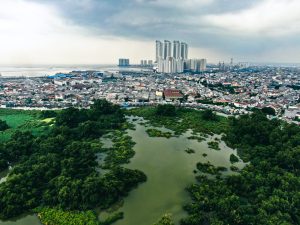
Yayasan Konservasi Alam Nusantara (YKAN) and the Jakarta Natural Resources Conservation Agency (BKSDA Jakarta) extended an invitation to journalists to participate in a mangrove tree planting event at the Muara Angke Wildlife Reserve (MAWR). This activity served the dual purpose of highlighting the significance of protecting Jakarta’s mangrove forests, which face increasing pressure due to nearby development activities.
On 25 May, three days after the International Day of Biological Biodiversity (22 May), YKAN, BKSDA Jakarta, and journalists, including NOW! Jakarta, came together to preserve the Muara Angke Wildlife Reserve in North Jakarta. This reserve is home to the city’s only mangrove forest. The event, titled “Mangrove Jakarta untuk Siapa?” (Mangrove Jakarta for Whom?), aimed to raise awareness about the importance of preserving mangrove forests.
Following the planting of mangrove seedlings, the journalists engaged in a clean-up operation, removing invasive plants such as water hyacinth from the mangrove forest area. Prior to the activity, the journalists participated in an interactive discussion led by Mufti Ginanjar, the Head of Conservation Section Region III BKSDA Jakarta, and Muhammad Ilman, YKAN’s Marine Program Director.
“Mangroves are a highly unique ecosystem that requires our protection. They act as a balancing force and a barrier between the sea and the land. In 2021, Indonesia’s mangroves covered an area of 3.36 million hectares, making it the largest mangrove area in the world. The most extensive mangrove areas are found in Maluku and Papua, accounting for 1.79 million hectares. With an area of 25.02 hectares, the Muara Angke Wildlife Reserve emphasizes the crucial need to protect mangroves, particularly for those of us living in urban areas,” explained Muhammad Ilman.



Muara Angke Wildlife Reserve, located in North Jakarta, is the smallest wildlife reserve in Indonesia and represents one of the last remaining mangrove ecosystems in the city. Despite its limited coverage, the mangrove forest within the reserve plays a vital role in supporting the lives of Jakarta residents and mitigating major natural disasters, such as tidal floods.
“As citizens of an archipelagic country, it is our responsibility to address the issue of global warming. The preservation of mangroves is pivotal to maintaining a stable climate. Indonesia’s role in mitigating climate change is of utmost importance, and the restoration of mangroves significantly impacts global climate issues. Despite its small area, Muara Angke Wildlife Reserve serves as an oasis within the city, managing waste and pollution while contributing to pollutant control,” elaborated Mufti Ginanjar.
According to BKSDA Jakarta, the designated agency overseeing the management of Muara Angke Wildlife Reserve, the area is home to eight mangrove species: Avicennia marina, Bruguiera gymnorrhiza, Nypa fruticans, Rhizophora apiculata, Rhizophora mucronata, Sonneratia caseolaris, Acrosticum aureum, and Excoecaria agallocha. Mangroves offer numerous benefits, including freshwater storage, oxygen supply, carbon dioxide absorption, hydrological regulation, pollutant absorption, biodiversity provision, and landscape beautification.

Since 2018, BKSDA Jakarta has collaborated with YKAN to restore MAWR, which involves installing a garbage barrier along the Angke River banks, weed control, hydrological improvements, and substrate stockpiling in areas prone to inundation. This restoration process has started yielding positive results. A study conducted from December 2022 to January 2023 revealed the natural recruitment of Sonneratia caseolaris, as well as an increase in bird and snake species.
The study documented 60 bird species (20 water bird species and 40 land bird species) and 16 reptile species, indicating a post-restoration increase from the previous numbers of 57 bird species (recorded in 2021) and 10 reptile species (recorded in 2019). Bird species showing an increase include the sea cockerel, finches, peking bondol, ivory pigeon, and Javanese chili. Additionally, waterbird species such as the Asian cormorant and great egret, both likely migratory birds, have also seen population growth.
During the study, a new species of snake, the red-eyed snake (Ahaetulla cf. rufusoculara), was discovered, requiring further research. This snake species was previously known to exist only in Vietnam and had never been recorded in Indonesia.
“If effectively and sustainably managed, mangroves serve not only as protection against natural disasters like tsunamis, storms, or sea waves but also as a source of income. Mangrove ecosystems are closely linked to climate change. Given Indonesia’s significant role in mitigating global climate change, the protection and restoration of mangrove ecosystems become vital steps that we must take collectively to demonstrate our concern for the world,” emphasized Muhammad Ilman.
For more information: www.YKAN.or.id.







